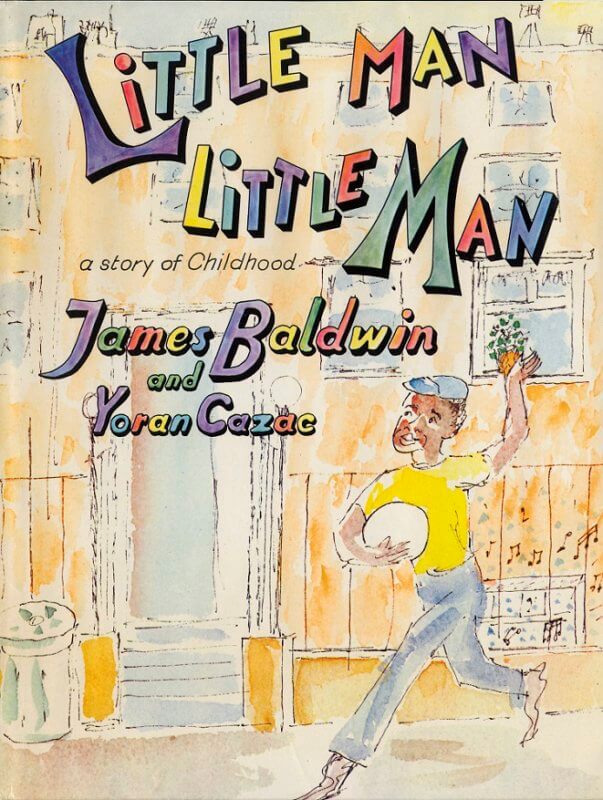11 Jul / Little Man, Little Man: A Story of Childhood by James Baldwin, illustrated by Yoran Cazac [in Shelf Awareness]

 To his New York City nephew and niece, iconic author and civil rights activist James Baldwin was mostly known as “Uncle Jimmy,” although the siblings would realize soon enough that he was also “a famous writer” of world renown. “When you gonna write a book about MeeeeEEE!?” nephew Tejan Karefa-Smart once asked. This book, Little Man, Little Man, was his answer.
To his New York City nephew and niece, iconic author and civil rights activist James Baldwin was mostly known as “Uncle Jimmy,” although the siblings would realize soon enough that he was also “a famous writer” of world renown. “When you gonna write a book about MeeeeEEE!?” nephew Tejan Karefa-Smart once asked. This book, Little Man, Little Man, was his answer.
Four-year-old TJ runs up and down his street playing ball. His two most constant companions are an older boy and girl – seven-year-old WT, “who like a brother,” and eight-year-old Blinky, who “[l]ook like she do everything she can to be a boy.” Around their Harlem neighborhood, Mr Man, the building janitor, “always try to act like he mean. He ain’t mean, but he getting pretty old” – he’s “about” 37. TJ runs errands for Miss Lee, who’s married to Mr Man, and for Miss Beanpole, who lives behind multiple locks and observes the outside world only from her window. Through the course of a day, Baldwin presents TJ’s personal microcosm, describing the “little store” run by a Puerto Rican man, front steps and fire escapes, the local bar, and churches.
Subtitled “A Story of Childhood,” TJ’s youth doesn’t protect him from mature realities. WT and Blinky both come from broken families with missing parents; WT’s older brother is lost to drugs. Alcoholism, police abuse, domestic violence and poverty plague friends and neighbors. TJ’s family seems contentedly intact, but, despite having two loving parents, TJ is constantly “afraid something happen to them” – childhood innocence is something he’s never known.
Originally published in 1976, Baldwin’s only children’s title (originally described as “a child’s story for adults”) did not initially fare well. After being deemed “a slight book” by the late children’s writer Julius Lester in a 1977 New York Times review, Little Man quickly disappeared from bookshelves. Four decades later, Duke University Press resurrects Baldwin’s self-described “celebration of the self-esteem of black children,” enhanced with a foreword by Baldwin’s book-requesting nephew Tejan, an afterword by Baldwin’s niece and Tejan’s older sister Aisha Karefa-Smart, and a context-rich introduction by Baldwin scholars Nicholas Boggs and Jennifer DeVere Brody. The new edition retains the original illustrations created by Yoran Cazac, a Caucasian French artist with whom Baldwin chose to collaborate despite Cazac’s lack of personal experience with New York City. Although the Harlem cityscapes aren’t particularly recognizable, Cazac’s colorful sketches prove wholly capable of capturing the expressions and energy of Baldwin’s characters. The intriguing pairing continues to inspire Boggs, a New York University English professor, who’s currently writing a book of his own exploring the Baldwin/Cazac relationship.
At 42, Little Man, Little Man has aged well. What might have been permanently dismissed as a “book [that] lacks intensity and focus” has instead matured into a timely representation of an urban African American childhood, presented in “the black vernacular style of [Baldwin’s] Harlem neighborhood,” made accessible once more to eager new audiences.
Shelf Talker: James Baldwin’s only children’s book – written to fulfill a promise to a young nephew – re-emerges in a new edition enhanced with illuminating familial and academic context.
Review: “Children’s Review,” Shelf Awareness Pro, July 11, 2018
Readers: Children
Published: 1976, 2018 (new edition)
